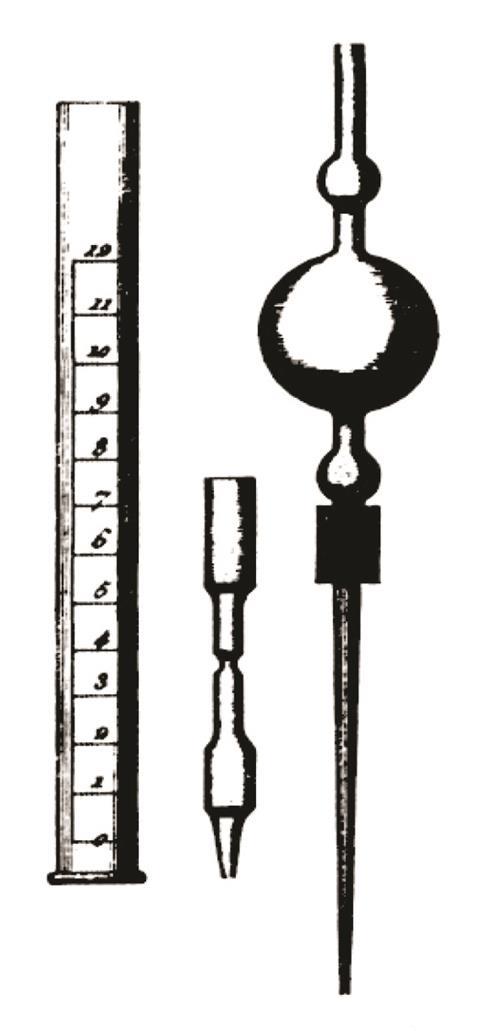François-Antoine-Henri Descroizilles. French chemist (1751–1825) and inventor of titration
For some, titrations are the great bores of school chemistry. As a medic I met at a party recently put it: ‘The sheer pointlessness of it – and the repetition – turned me right off chemistry’. In my own department titrations have steadily disappeared from the undergraduate laboratory to be replaced by sexier practicals. At their inception, however, titrations were seen as an extraordinary advance: a huge time-saver compared with the more common gravimetric analysis and as they spread, titrations came to underpin both the economics and the regulation of industry. It can even be argued that the titration was one of the reasons for the growth of chemistry as an academic discipline through the 19th century.

Until the end of the 18th century, the only way to lighten the colour of cloth was the same as had been used by the ancient Greeks: leave fabric in the sun for weeks at a time, moistened either with urine, vegetable oil or sour milk. Carl Wilhelm Scheele’s discovery of chlorine in 1774 changed everything. The foul-smelling greenish gas showed an astonishing chemical promiscuity, and Scheele noticed the way in which it discoloured many organic materials. In Britain, Charles Tennant began to manufacture bleaching powder by combining chlorine with lime, while in France Claude-Louis Berthollet began to repeat Scheele’s experiments. Berthollet rapidly established that chlorine dissolved extensively in alkaline solutions, and that these solutions were powerful bleaches. These impressive results led Berthollet to help set up a bleach manufacturing plant in Javel, then outside Paris – chlorine bleach has been known as ‘eau de Javel’ ever since.
Berthollet’s chemical work led to his appointment as professor at the University of Paris, and as director responsible for dyeing at the royal tapestry works at the Gobelins. Soon, word about the remarkable properties of the bleaches spread across France as Berthollet’s students visited factories and universities to give demonstrations. In 1788, Berthollet’s student Bodeau de Grancourt travelled to Rouen armed with letters of recommendation to convince the local industrialists of the value of the new bleaching water. The demonstration was a memorable disaster – while some threads were unchanged, others were irreparably burned by the chlorine. But the commission of judges included the young chemist Francois-Antoine-Henri Descroizilles; rather than dismissing the idea, it set him thinking.
Born in Dieppe, the sixth generation of a family of apothecaries, Descroizilles had travelled to Paris and studied with both the flamboyant autodidact lecturer Guillaume-Francois Rouelle and his botanist brother Hilaire. Descroizilles began working in a bleaching works which he marketed as the ‘blanchisserie methode Berthollet’ and referred to his workers as ‘Bertholleurs’ to give due credit to the inventor.
What had struck him particularly about the Rouen demonstration was the lack of control. How could one bleach reliably without knowing how much ‘oxygenated muriatic acid’ (as he called chlorine) was present in the liquid? The Rouelles had introduced him to the tincture of violets indicator, and Descroizilles decided to use the bleaching of the intensely-coloured indigo as an indicator of the potency of his bleach.
To do this, he devised an instrument, the ‘Berthollimêtre’. First, he sealed one end a one-inch diameter glass tube using a flame. The tube was then calibrated using a small dropper device to introduce a reproducible slug or amount of liquid. To mark the tube, Descroizilles recommended waxing the tube and then using a sharp tip to inscribe the wax with the level of successive slugs of liquid. Suspending the waxed tube into a vapour of hydrofluoric acid (made by adding sulphuric acid to fluorspar) etched the markings permanently in the glass. Thus ‘genius and chemistry wept together on Scheele’s tomb’.
Now measurable quantities of bleach could be added to the bottom of the tube. A bulbous pipette was then filled with a deep blue 1% solution of indigo in sulfuric acid and added slowly into the tube with vigorous stirring. As the liquids approached the ‘point of saturation’, the indigo decolourised more slowly and turned an olive colour. The strength of the bleach could be determined by the total volume in the tube. It was perhaps the first real titration.
Although Descroizilles was also to invent the first filter coffee maker – it hugely impressed everyone who drank from it – he soon realised that his stepwise addition method offered an improved way to quantify acids and bases. He developed an ‘alkalimeter’ method, similar in concept, in which an acid of known concentration was added until an indicator changed colour. Descroizilles claimed to be able to conduct a measurement in eight minutes, and this speed and wide applicability led to a rapid chemical evolution. Reagents soon began to be delivered by pouring from a burette – which Mohr displaced in the 1850s with the familiar graduated tube with a clip or stopcock at the bottom.
It seems ironic that while doctors and nurses routinely optimise the dose of a drug by systematically varying the amount given to patients, chemical titration is seen as dull. Is it the concept that is boring? Or is it the problems that we give students in the lab? Maybe it’s time to improve our practicals…
References
Descroizilles F-A-H, Journal des Arts et Manufactures, 1795, 1, 256












No comments yet